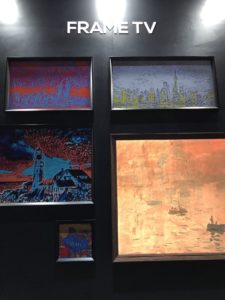 It’s routine for me. Fall ushers in the holidays. It starts with Thanksgiving. Then Christmas. And then the New Year. And then comes CES. Yeah, CES is like a holiday all of its own to this tech geek. I’ve always been an early adopter of new tech so it’s no surprise I ended up in a technology field or that I holiday-ize (my word) the Consumer Electronics Show.
It’s routine for me. Fall ushers in the holidays. It starts with Thanksgiving. Then Christmas. And then the New Year. And then comes CES. Yeah, CES is like a holiday all of its own to this tech geek. I’ve always been an early adopter of new tech so it’s no surprise I ended up in a technology field or that I holiday-ize (my word) the Consumer Electronics Show.
For those not familiar, CES is arguably the world’s largest technology show, boasting over 4400 exhibitors spread across almost 3 million net square feet of exhibit space. With about 175,000 attendees (Las Vegas only has roughly 150,000 hotel rooms) from all over the globe it’s fair to say CES takes over Vegas for nearly a week every January.
Over the 10 years I’ve been attending the show, I’ve seen successes like the birth of Alexa to the failure of 3D TV’s. Fresh with a new pair of Nike Air walking shoes, I headed out in search of what was new and noteworthy in the decade of 2020.
DISPLAY TECHNOLOGY
To be honest, not much has changed in the last year for TV tech. But the show had no shortage of absolutely incredible displays. Bigger, brighter, and more pixels from companies like Samsung, LG, Sony, Vizio and others. While most of America hasn’t even purchased their first 4K TV yet, the show’s vendors were primarily highlighting their 8K lineups. For the mathematically challenged, that’s double the number of pixels that those pesky old 4K TV’s have.
If you’re not familiar, just think the higher the “k”, the more pixels, hence, a clearer picture. As always with new technology, finding 8K content is rare, so you can hold off on any expensive 8K TV purchase right now. I’m going to go out on a limb here and say CES 2021 will likely start showcasing 16k TV’s too. So what does all this mean? Can you ever buy a TV and not feel like it’s outdated as soon as you hang it on the wall? Last year I made a somewhat controversial claim that to the human eye you really can’t tell much difference between 4K and 8K for general TV viewing. I stand by this, but I’ll add one footnote. The only exception to this seems to be the larger you make the screen. But since most average households probably max out at 55″ or maybe even 65 inch TV, you would have a hard time telling the difference. In short, if you just bought or plan to buy a 4K TV don’t worry, you’re still good.
LG Electronics always shines as the first booth you immerse yourself in entering central hall. And I truly mean immerse. For 2020 LG had an incredible OLED TV wave display. It’s made up of 200 TV’s, a mixture of concave, convex and flat screens with some of the most stunning visuals you’ll see. Their display was 20 feet high and 82 feet across with a couple mirrors thrown in for good measure. This is nothing you’ll be seeing in stores, it’s clearly for the WOW factor that it certainly achieves.
Another trend gaining more traction this year are televisions designed to blend in. That is, when you’re not watching them they look like a fancy painting . When in art mode you can barely tell it’s a TV because it’s so miraculously thin like this LG GX Gallery Series 4K TV set.
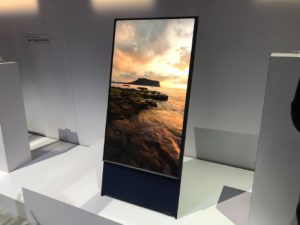
Samsung also created a new TV that no one really asked for. Well, maybe if you want to watch those iPhone videos of your pets or kids when you forgot to turn the camera to landscape mode. You see, the Samsung Sero can actually rotate itself into portrait mode for those annoying videos where you usually see black bars on the side.
There are far too many worthy displays at CES to mention in this post, including improvements to LG’s rollable TV I featured last year, and the mammoth Samsung 292 inch micro LED bevel free TV aptly called The Wall. It’s modular so you can make all kinds of sizes.
You can actually buy a version of it today online for $20,000. Check out the video below and don’t be fooled– the whole thing you’re seeing is the TV!
VEHICLE TECHNOLOGY
The North Hall of the Las Vegas convention center is filled with all the automotive tech. Just like last year, there’s a big push from automotive and electronics companies to make connected self driving cars we’ll all take in the future. This LG car offers a truly unique experience for any destination. Even Sony had their own car this year. It’s just a one off prototype vehicle that demonstrates all the different technologies Sony is involved in, which is a lot, but regardless it’s surreal to see a vehicle branded as the same as my stereo receiver.
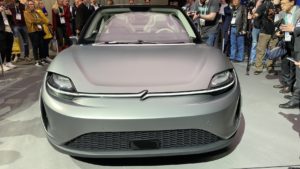
Other companies focused on the simpler things. Like improving age old ideas like a sun visor. Bosch’s Virtual Sun Visor only blocks the light focused at your eyes and offers transparency for the rest of the visor. I love this idea, and it’s nice to see something like a car visor which has been around since the 1920’s get a technology upgrade.
Mercedes made a big splash this year with their Avatar movie car tie in. It’s pretty insane and interesting at the same time. The Mercedes Vision AVTR is, of course, a concept car so don’t expect it at your dealer anytime soon. The car has spherical wheels that can allow the car to move sideways–yes– sideways, and even diagonal. It also has scales.
So a lot of the cars at CES are so prototype that you’ll likely never see them in production. So let’s talk about two that you will. The Mustang and the Byton — two vehicles I’m interested in.
Ford did an impressive job with their booth showcasing the upcoming Ford Mustang Mach E. Yes, there’s loads of controversy over an SUV with the name Mustang, but this 2021 all electric ‘stang has a model that can go from 0-60 in 3 seconds and will have over the air updates for future self driving options. It also boasts the latest version of Ford Sync version 4A. Check out the impressive booth display with the sideways mounted Mach E , or if you want to learn more about the Mustang I’ve linked the LA Auto Show presentation I recorded here.
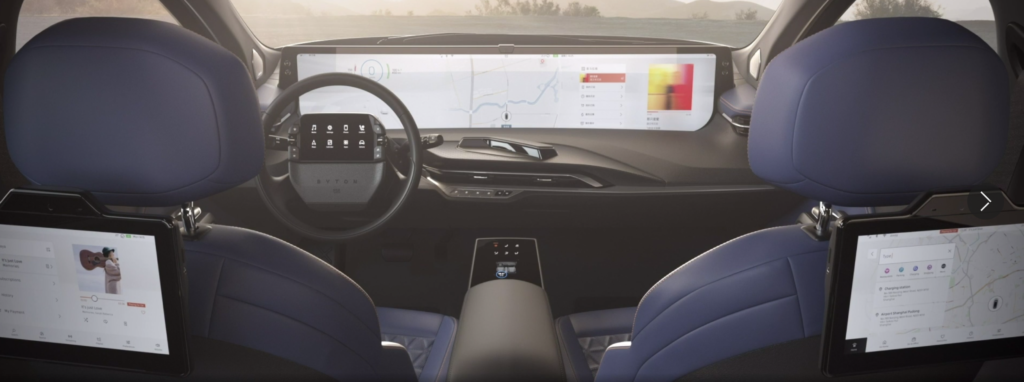
I would be remiss to not mention the Byton M-BYTE, the electric SUV which I have had my eye on every year since they debuted at CES 2018. This electric SUV features a massive 48″ high resolution shared experience display along with high tech enhancements like facial recognition and gesture control.
This Chinese startup company has some big names behind them and they hope to have the M-BYTE available in the states in 2021. They’re planning some unique retail marketing plans, including a LA showroom in the near future. I’ve already reserved mine (no charge or obligation) on the Byton website. If you want to see a glimpse at the near future of vehicle technology that really will happen (as opposed to something as cool as the sidewinding Avatar vehicle), check out this SUV.
And lastly I want to mention that vehicle technology was not limited to asphalt again this year. Hyundai and Uber showed off their flying taxi that’s supposedly ready to hit the skies in 2023. Bell Nexus once again featured their air taxi which is set to carry passengers around the skies in 2025. Not sure what these future vehicles remind you of, but all I have to say is: “Jane! Stop this crazy thing!”
5G UPDATE
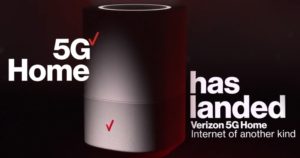
I covered a lot about the incoming 5G domination last year. Things are chugging along for 5G with some mobile phones capable of the faster data rates available today. 5G Internet is starting to be marketed nationwide. Companies like AT&T are already adding misleading “5G” labels on their phones. But if you remember, 5G is much more than faster downloads. It’s the technology that will usher in self-driving vehicles and power our smart or connected cities. The best demonstration I received of how 5G will impact our lives this year was at the Samsung booth. They called it 5G and Vehicle to Everything and my colleague Russ participated in a demonstration that I recorded below.
With 5G technology, everything is tracked and reported. Vehicle to vehicle. Vehicle to pedestrian. Vehicle to infrastructure, etc. Picture the example that you are in your car stopped at a cross walk. The countdown timer for walking pedestrians counts down from 30 seconds. One of the people crossing the street drops their phone in the crosswalk. This event is sent to vehicles and the traffic signal, which maintains the red light and restarts the crosswalk timer. That’s right–a dropped phone is controlling a crosswalk timer! That’s how hyper local 5G can be. It’s going to be millions of devices all talking to each other at high speeds with low latency connections that will allow for this massive coordination for safety and convenience. I feel that 5G will change our future.
ROBOTICS
Here’s a field that is constantly evolving. I don’t know how many science fiction movies have warned us about the future of robot overloads but we keep building them anyway. There was a high presence of both companion robots and workplace robots this year.
LG is betting big on their robot line called “CLOi”. The CLOi CoBot Barista robot makes coffee. The LG CLOi GuideBot brings food to your table. And yes, the waiter is also essentially eliminated in this scenario as you have a tiny CLOi bot at your table to take your order. In the below demo you see a server handing you your food but how long will it be until the robots just tell you to take your food from the tray?
And finally, I guess I have to talk about the Ball. Samsung’s BB8 inspired robot ball that rolls around your house and makes your life better. Check out their promotional video below.
OTHER TECH
ARTIFICIAL HUMANS?
From the minds of Star Labs (gotta love the Flash reference) NEON debuted their artificial humans at CES 2020. These avatars can converse and sympathize like real human beings. Their presentations were so packed it was difficult to figure out just exactly what these things were. But after some research I’ve determined they’re a grown up version of the Microsoft paperclip assistant. Only you get these virtual beings as life-sized avatars in your home or business that can truly interact.
Star Labs says these NEONS can be your next financial advisor, a hotel receptionist, or just your friend. The company has only been working on these for around four months, so many of their demos were littered with bugs. They next hope to introduce AI and machine learning, emotions, and memory abilities to NEON. But it’s important to know they’re not going for the all-knowing Siri or Alexa assistants where you can ask them virtually anything. They’re reportedly being designed to “converse and sympathize like real people in order to act as hyper lifelike companions.” They have no body– yet. But they live in a life sized screen in your wall. I didn’t try it, but I assumed they would probably get upset if I tapped on the glass.
HIGHEST TECH SECURITY SYSTEM
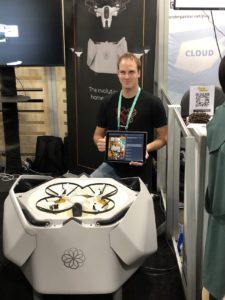
One of the things I like to see in technology is when creative people take existing technology and piece it together with other technology to make a viable product.
I found a real winner in that respect which is a security product by Sunflower Labs. Their Autonomous Security Drones are meant to protect your property. Basically it works like this — your yard has 1 or more AI-powered activity sensors which sense motion. If it’s out of the ordinary, out pops a fully autonomous drone that navigates safely to observe activity on your property and report back to you via their app. It makes RING video doorbells seem like the door knocker.
I joked with the representative and asked them if they were equipped to shoot lasers at any suspicious targets. It appears adding lasers has been a joke at the company since inception. But for now the off the record talk was just about using laser pointers.
Come to think of it, that just might do the fright trick itself.
“FROM THE MOST DISTURBING” FILE…
A startup company called VIVOKEY had a tiny quiet table amongst neighboring tech. But what was on their table caught my eye.
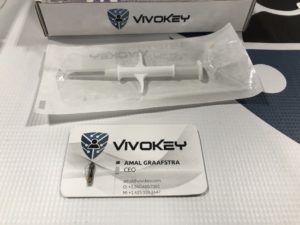
A syringe looking device designed to add an implant under the skin. Not for your dog or cat. For you! Vivokey’s marketing offers you to replace keys, cards, badges, and passwords with a secure chip implant and they say it can give you easy access with just a wave of your hand.
The representative at the table saw my wide-eyed expression as I learned we’re literally chipping humans now. He proudly showed me his implant marking on his hand. Now don’t get me wrong, I hate remembering passwords, PIN codes, door lock codes, etc., but there’s something a little disconcerting about actually having a cryptobionic implant under my skin. Health, security issues and end of days just to name a few.
These NFC implant chips are said to be able to allow you access to doors, log you into Netflix, give you access to public transit, and would at some point authenticate you at an ATM. That all sounds good. Until I look and see a chip under my skin. Maybe I’m just too old (and wise) for this. I’m sure there’s a long list of Gen Z’ers that will line up for this. I applaud their effort, but I’m going to pass.
RIDICULIST
In CES holiday tradition, I feel obligated to once again end my coverage with the ridiculist. There were quite a few contenders for the list this year. And surprisingly two on the list come from Proctor and Gamble’s entry into technology.
SmellSense is a sensor that sits in your bathroom and notifies you when the bathroom smells like, well, poop. There’s some sophisticated science behind this I’m sure but I’m uncomfortable even typing about this much as less having that app on my phone.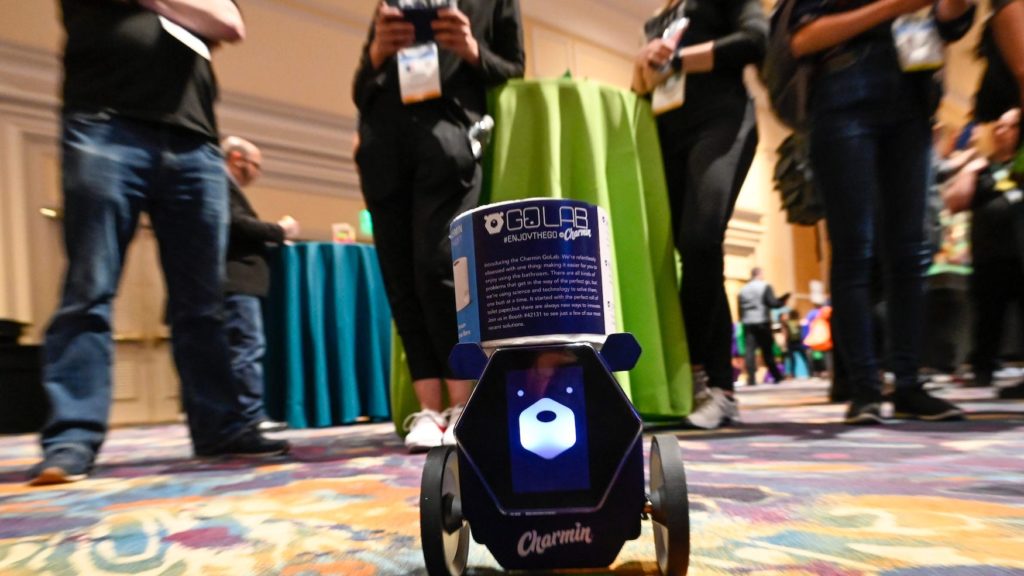
Their second product on the list is called GOLAB, and it’s for all those times you’re on the toilet and you realize you have no toilet paper. Yep, summon the Charmin bear looking robot with a roll of toilet paper on its head to the rescue. If there’s no stairs involved, and your dog doesn’t attack the rolling misfit toy, maybe it will deliver you from this awkward situation we’ve probably all experienced at one time or another.
Note to Charmin and Proctor and Gamble. Stick with what you know. Laundry detergent, diapers, and shampoo. You’re great at these things. But please leave the TP robots and smell detectors to…well, no one.
CES Coverage by Tom Hanberg | Skyhound Internet www.skyhoundinternet.com

